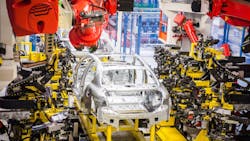The speed at which manufacturers must evolve their approach to manufacturing and reduce time to market has only been increasing as front-office business systems and associated corporate goals are increasingly tied to plant-floor activities. Of course, all these changes to the manufacturing process have to be achieved without negatively impacting quality or performance. It’s a tall order, but one that’s playing out across global industries regardless of the high demands.
One of the industries most dramatically affected by this is the automotive industry. The focus on cost-effective ways to reduce time to market while maintaining quality has led many automakers to streamline their design and implementation processes, use lightweight materials and new assembly techniques for multi-material vehicles, and leverage model flexibility with random build sequencing.
To support these changes in the automotive industry, automation suppliers have been investing in computer-aided design (CAD) technologies to optimize the effectiveness and quality of new production lines. CAD technologies enable the use of virtual simulation to fine tune engineering and programming before the actual rollout of a new production line. Comau, a supplier of automotive body and powertrain manufacturing and assembly technologies, as well as automation and robotics technologies, has been particularly focused on bringing such virtual commissioning capabilities to its automotive customers.
“Virtual commissioning enables engineers to create a replica of production equipment—complete with all the related electrical, hydraulic, mechanical and pneumatic support systems—before the commissioning phase in the plant using a 3D virtual environment to run the real programs and processes,” says Francesco Matergia, Comau’s head of engineering, automation systems EMEA. “Engineers are able to debug the PLC, the HMI and robotic programs in a virtual environment, which can shave weeks or even months off the launch time with higher overall quality.”
The ability to use virtual commissioning to connect PLCs to the virtual manufacturing cell allows engineers to validate the processes and de-bug the system before the physical deployment of the line itself. Comau can “ensure line readiness such that the actual installation onsite is fast and easy with few, if any, issues to resolve. In addition, because the line has been fine-tuned before its deployment, the minor issues that may emerge during the installation process can be quickly solved,” adds Matergia.
Matergia adds that virtual commissioning can also play a role in the move toward adoption of the Industrial Internet of Things—and Industry 4.0 in particular. “As improved data and computing capabilities merge with advances in automation, intelligent robotics, additive technologies and human-machine collaboration, digital connectivity across the entire manufacturing chain will enable automakers to further improve operational efficiencies while accelerating product and process innovation,” he says. “Comau’s virtual commissioning process can be used to simulate and debug the data collection capabilities of a new line to ensure optimal communication between the various machines, the production targets and the manufacturing flows. The use of virtual commissioning within the engineering and rollout of a new manufacturing line adds value on multiple levels.”
With multiple virtual rooms in its global engineering centers, Comau is able to integrate the virtual commissioning process globally. This allows for the verification of complete build specifics and cycle times of a production line, rather than just verifying a few machines or robots at a time. It also allows for the modification of variables during the design and build phase that could be caused, for example, by changes in the vehicle design. These changes “can be easily integrated into the PLC and robots without having to shut down the entire line,” says Matergia. “In fact, the company was recently able to reprogram 200 robots in just three days using virtual commissioning as opposed to roughly 10 weekends had the work been done on the factory floor.”


